Exchange traded funds or ETFs are mutual fund schemes whose units are listed on stock exchanges. Investors can trade in units of an ETF just like they trade in equities in trading hours. In an open-ended traditional mutual fund scheme, units are bought from and sold to mutual fund houses. However, in the case of an ETF, units are transacted between two investors. Since the transaction of buying and selling ETF units takes place on the stock exchange, there is no counterparty risk.
ETFs invest in various asset classes in line with their investment objectives and asset allocation stated in the scheme information document. In India, we have ETFs that invest in stocks, bonds and gold.
Stock ETFs: These invest in shares of various companies. Some ETFs track large-cap indices and mid-cap indices. There are also ETFs that track sectoral indices or thematic indices. Stock ETFs are suitable for aggressive investors looking for long-term investments in stocks. UTI Mastershare was the first closed-end equity fund to be traded on stock exchanges in India and can be considered as a ‘first’ ETF-like vehicle for Indians. It was converted into an open ended fund in 2003. As on September 30, 2021 the largest stock ETF in India—SBI ETF Nifty 50—has Assets Under Management (AUM) worth ₹1,19,873 crore.
Debt ETF: ETFs also invest in bonds. They have a clearly defined investment mandate and asset allocation. There are a few ETFs that operate like a liquid fund by investing in very short-dated bonds or overnight securities. Of late, fund houses are experimenting with debt ETFs and offering debt ETFs that invest in long-term bonds. There are some target-maturity debt ETFs that mature on a predetermined date. Conservative investors who want to protect their capital and earn reasonable returns invest in units of debt ETF. Edelweiss Bharat Bond ETF-April 2030 is the largest bond ETF in India with assets under management worth ₹12,365 crore.
Gold ETFs: These ETFs buy bullion gold and issue units against it. The units of gold ETF used to track the price of one gram of gold. However, over a period of time, to make them accessible to small investors and to improve the liquidity, the units have seen sub-divisions. Units of gold ETFs still follow the movement in gold prices. If gold prices go up, the value of the gold ETF units rises. Investors looking to diversify and invest in gold, opt for units of gold ETFs. In this sub-segment, Nippon India ETF Gold BeES, the largest gold ETF, manages assets worth ₹6,004 crore.
According to monthly data released by Association of Mutual Funds in India (AMFI) as on September 30, 2021 gold ETFs have ₹16, 336 crore in assets under management. All other ETFs put together have assets worth ₹3,62,926 crore under management.
Recently, the Securities & Exchange Board of India (SEBI) has given in-principle approval to the mutual fund industry to launch a silver ETF.
Globally, ETFs also invest in commodities, bitcoins and currencies.
ETFs can be actively managed or passively managed. In India, most ETFs are passively managed. To put it simply, a passively managed ETF tracks an index or the price movement in a specified underlying asset. A fund manager buys constituents of an index in the same proportion as they are in the index. A passively managed ETF thus attempts to replicate returns offered by an underlying index, before expenses and tracking errors.
A market maker or large institutional investor may approach a fund house with either cash or securities. The fund house in return issues units of ETFs backed by the necessary underlying asset. This is termed as creation of ETF units. The market maker or the investor later can sell these units in the market by adding a small mark-up on the net asset value. Like any other mutual fund scheme, the net asset value of the units of an ETF depends on the valuation of all its assets.
How are ETFs different from regular mutual funds?
These are are some key areas of difference between ETFs and regular or non-ETFs mutual funds:
Counterparty
As mentioned earlier, when an investor transacts in units of an ETF, he/she is buying from or selling to another investor. Only at the time of a new fund offer of an ETF, are investors allotted units by a fund house. In the case of open-ended (regular) mutual fund schemes, investors buy units from a mutual fund company and sell it back to the mutual fund company.
NAV
The NAV of ETF keeps changing throughout the day and the secondary market price also changes accordingly. The price quoted on a stock exchange may be at a premium or at a discount to the NAV of a scheme. In case of open-ended mutual funds, the NAV is computed at the end of the business day, and transactions in the units of the scheme are carried out on the basis of that NAV.
Savvy investors can take advantage of intraday volatility in a broad market index or a sectoral index by investing in the ETF tracking it. Prices of such ETFs reflect intraday moves in the underlying index on a real-time basis. Since open-ended schemes operate on the end-of-the-day NAV basis, they cannot be used to take advantage of intraday moves.
Liquidity
In case of regular open-ended mutual fund schemes, investors are assured of liquidity at the NAV at the end of the day. However, in the case of an ETF, liquidity is not assured. In case of schemes where AUM is large and units are widely held or a fund house has appointed a market maker for units of an ETF, investors can expect reasonable liquidity. In many ETFs in India, liquidity remains a concern, though the situation is expected to improve as investor participation goes up.
Expenses
Open-ended mutual fund schemes have two plans: regular or distributor plan and direct plan. The expense ratio of these plans is generally higher than the expense ratio charged by ETF. The base total expense ratio of the regular plans of an open-ended scheme can go as high as 2.5%. ETFs do not have such separate plans and have one expense ratio. Their expense ratio is generally low. Some ETFs tracking Nifty 50 index charge as low as 5 basis points (0.05%) towards expenses. The distribution expenses are borne by investors while transacting in units of the ETF on a stock exchange.
Demat account
There is no need to open a demat account to invest in units of a regular open-ended mutual fund scheme. However, to buy units of the ETF through a stock broker, you need to open a demat account. To enable purchases by investors without demat accounts and to assure liquidity, some fund houses have launched Fund of Fund (FoF) schemes investing in units of ETFs.
Investing through an SIP
You can invest in units of an open-ended mutual fund scheme through a systematic Investment plan (SIP). A fund house can issue fractional units against the money received wherever applicable. When you are investing in an ETF on a stock exchange, you have to buy units. You cannot trade fractions on Indian stock exchanges. Further, SIPs are not available in ETFs. Some brokers allow a facility called stock SIP. By availing such a facility, the investor can place a buy order at regular intervals to purchase units of an ETF.
What is the difference between index funds and ETFs?
Many a time, investors are unable to distinguish index funds from ETFs because many ETFs are passively managed funds. Index funds are passively managed schemes with open-ended fund structure. These two categories of funds differ on all those parameters on which the open-ended regular funds differ from the ETFs.
In case of index funds and open ended funds, either a mutual fund house takes an active part in distribution activities, under the direct plan or relies on mutual fund distributors to sell these products or does both. In case of ETFs, it is more of a pull product wherein investors choose to invest in units of ETFs listed on the stock exchange.
Are ETFs a right investment avenue for you?
Rising investment in ETFs is a global phenomenon. It has caught on in India because of several reasons. Investors who look for low-cost investment vehicles for long-term investing opt for ETFs. Further, ETFs offer diversification, as they invest in various sectors, asset classes and also geographies. Investors seeking diversification across asset classes can achieve that by investing in units of ETFs.
Passively managed ETFs do away with the fund manager risk. Such schemes help investors to earn market returns at minimal costs. Investors content with market returns or investors keen to avoid fund manager risk go for ETFs.
There are three key factors investors should keep in mind while selecting an ETF.
Liquidity: This is an extremely important factor while investing in an ETF. Units of ETFs should trade as close as possible to the NAV of the ETF. It should have a sizable trading volume. If there is not much volume, then the investors may not get an exit at the fair price of the unit.
Expense ratio: Lower the expense ratio, the better it is. Money saved on the expense of schemes tends to get added to the returns of an investor.
Tracking error: In case of passively managed ETF, the fund manager should replicate the index while investing the scheme’s money. The tracking error, which is the difference between the index returns and the scheme’s returns, should be minimal.
These aspects provide an idea of why ETFs have acquired so much importance in recent years. In the context of these facts, investors should constantly reassess their asset allocation and invest in these funds based on their financial goals and risk profile.
Want to check out ETF smart lists on Upstox?
Go to the Discover section in our new app and look for the 'ETF' smartlist.



